Back to the list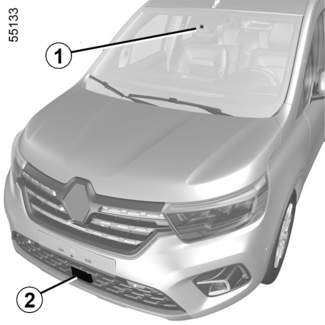
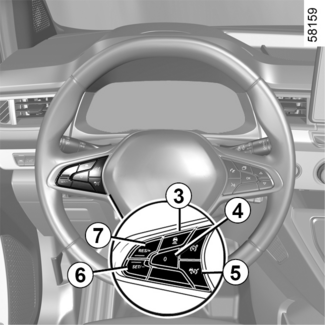
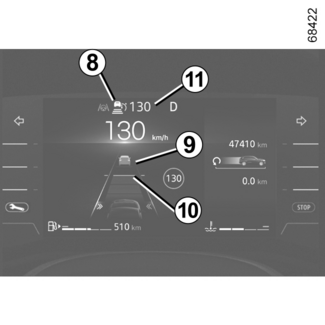
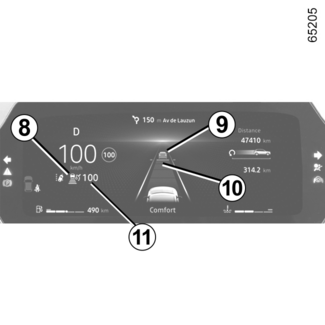
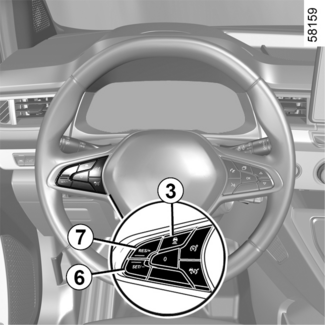
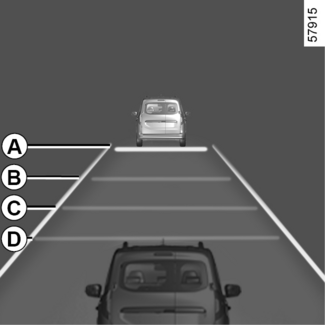
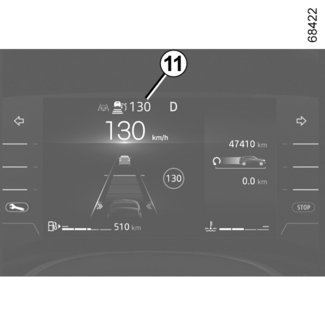
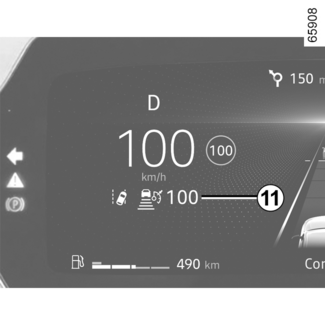


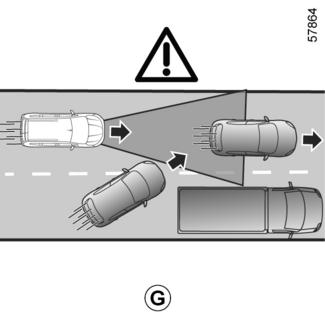
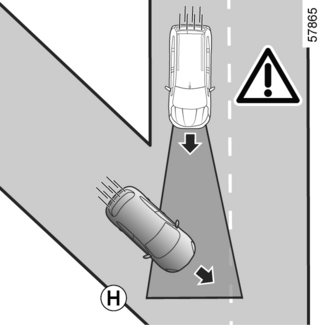
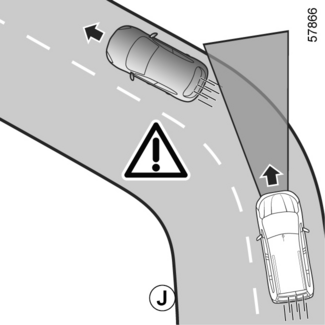
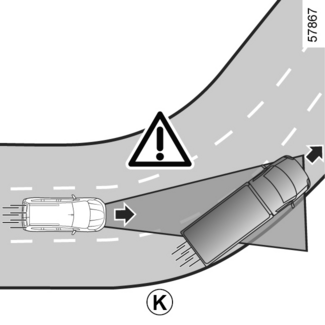


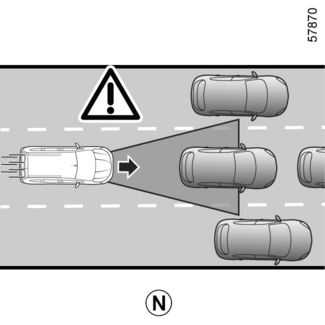
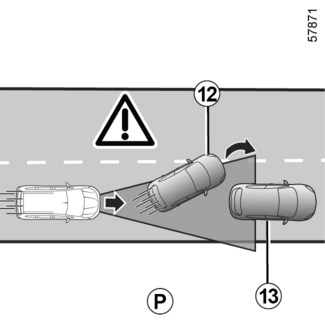
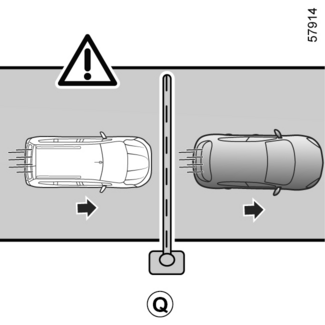
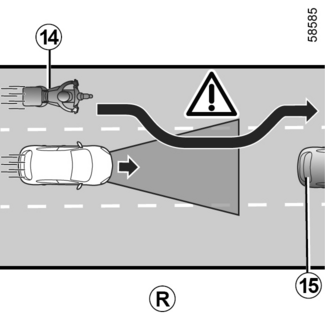
Adaptive cruise control
Adaptive cruise control
Based on information from a radar or camera, the Adaptive Cruise Control function
(or Stop and Go Adaptive Cruise Control function on vehicles equipped with an automatic gearbox)
enables you to maintain the speed selected (known as cruising speed) while keeping
a following distance with the vehicle in front in the same lane.
Depending on the vehicle, when the "Road Sign Detection" function is activated DETECTION OF ROAD SIGNS, the system can adapt the speed of your vehicle according to the speed limit signs
recognized by the camera.
On vehicles fitted with an automatic gearbox, if the vehicle in front stops, the Stop and Go adaptive cruise control function may apply the vehicle brakes to a full-stop before
allowing the vehicle to move-on.
The system controls acceleration and deceleration of your vehicle using the engine
and braking system.
The system's maximum range is approximately 150 m. This may vary according to the
road conditions (ground relief, weather conditions, etc.)
According to conditions on the road (traffic, weather, etc.), the adaptive cruise
control function can be activated:
- 0 mph (0 km/h) to 106 mph (170 km) on vehicles fitted with an automatic gearbox;
- 19 mph (30 km/h) to 106 mph (170 km/h) on vehicles fitted with a manual gearbox.
The function is indicated by the  symbol.
symbol.
Note:
- the driver must observe the maximum speed limit and safe distances according to the legislation in the country where they are driving;
- the adaptive cruise control can brake the vehicle up to a third of the braking capacity. Depending on the situation, the driver may need to brake harder.
Tip
The adaptive cruise control does not trigger an emergency stop and its braking capability
is limited.
WARNING
This function is an additional driving aid.
It can under no circumstances replace the driver's responsibility to respect speed
limits or to be vigilant.
The driver must always be in control of the vehicle. The driver must always adapt
their speed according to the surroundings and traffic conditions. The adaptive cruise
control must only be used on a motorway (or multi-lane road separated by a barrier).
The cruise control must not be used in heavy traffic, on winding or slippery roads
(black ice, aquaplaning, gravel) or during bad weather (fog, rain, side winds etc.).
There is a risk of accidents.
Location of camera 1

Make sure the windscreen is not obscured (by dirt, mud, snow, condensation etc.).
Location of the radar 2
Ensure that the radar area is not obstructed (dirt, mud, snow, a badly fitted/attached
front number plate), impacted, modified (including paintwork) or hidden by any accessory
fitted on the front of the vehicle (on the grille or logo etc.).
Controls

- 3.
- Safe distance settings
- 4.
- Put the function on standby (with cruising speed stored) (0).
- 5.
- Stop and Go adaptive cruise control main on/off switch
.
WARNING
The radar and camera zones must be kept clean and free of any tampering in order to
ensure the proper operation of the system.
- 6.
- Activate, store and decrease the cruising speed (SET/˗).
- 7.
- Switch to activate and increase cruising speed or to recall the memorised cruising speed (RES/+).
Tip
You can link the Adaptive Cruise Control function to the "Road sign detection" function
DETECTION OF ROAD SIGNS.
Displays


- 8.
- Adaptive cruise control warning light.
- 9.
- Vehicle in front.
- 10.
- Stored safe distance
- 11.
- Stored cruising speed.
WARNING
Important: you should keep your feet near the pedals at all times to prepare for any
event.
Switching on
Press the switch 5.
The  warning light appears in grey and the "Adaptive Cruise Ctl ON" message appears on the instrument panel accompanied by dashes to indicate that the
cruise control function is activated and waiting to store a cruising speed.
warning light appears in grey and the "Adaptive Cruise Ctl ON" message appears on the instrument panel accompanied by dashes to indicate that the
cruise control function is activated and waiting to store a cruising speed.
This function cannot be activated when:
- the parking brake is applied;
- the Park Assist function is already activated ASSISTED PARKING.
The "Adaptive Cruise Ctl unavailable" message is displayed on the instrument panel.
Activating cruise control
When the vehicle is stationary (on vehicles equipped with an automatic gearbox) or
when the vehicle is moving at a steady speed (all vehicles), press switch 6 (SET/˗) or 7 (RES/+) to activate the function and store the current speed. The minimum cruising speed
is 19 mph (30 km/h).
The cruising speed 11 replaces the dashes and the  warning light and the cruising speed are displayed in green to confirm that the cruise
control function is in operation.
warning light and the cruising speed are displayed in green to confirm that the cruise
control function is in operation.
If you try to activate the function when the vehicle speed is over 106 mph (170 km/h)
or below 19 mph (30 km/h) on vehicles fitted with a manual gearbox, the "Invalid Speed" message is displayed and the function will remain inactive.
Once a cruising speed is memorised and the cruise control function is active, you
may lift your foot off the accelerator pedal.
Special feature on vehicles with an automatic gearbox: if the vehicle speed is below approximately 19 mph (30 km/h), the cruising speed
will automatically be set to 19 mph (30 km/h). The vehicle will accelerate until it
reaches the stored cruising speed.
Safe distance control activation
As soon as cruise control is activated, the default safe distance 10 is displayed in green on the instrument panel. The default following distance corresponds
to approximately 2 seconds.
If the system detects a vehicle in your lane, an outline of a vehicle 9 appears above the distance gauge 10 on the instrument panel.
Your vehicle adapts its speed to that of the vehicle in front and applies the brakes
if necessary (the brake lights come on) in order to maintain the distance displayed
on the instrument panel.
Note: the size of the 9 outline varies according to the distance separating you from the vehicle in front.
The larger the outline, the closer the vehicle in front.
Setting the cruising speed

You can vary the speed by repeatedly pressing (small increments) or pressing and holding
(large increments) switch 6 or 7:
- press switch "SET/˗" 6 to reduce the speed;
- press switch "RES/+" 7 to increase the speed.
Adjusting the following distance

You can vary the safe distance from the vehicle in front at any time by pressing switch
3 repeatedly.
The horizontal distance gauge on the instrument panel indicates the various available
safe distances:
- distance gauge A: long distance (corresponding to approximately 2.4 seconds);
- distance gauge B: intermediate distance 2 (corresponding to approximately two seconds);
- distance gauge C: intermediate distance 1 (corresponding to approximately 1.6 seconds);
- distance gauge D: short distance (corresponding to approximately 1.2 seconds).
The selected distance gauge appears in green on the instrument panel. The other gauges
remain in grey.
Note: the distance must be set according to the traffic level, local regulation and weather
conditions.
Tip
The safe distance is adjusted by default on the distance gauge B.
Exceeding the cruising speed


The cruising speed may be exceeded at any time by applying the accelerator pedal.
If it is exceeded, the cruising speed 11 appears in red.
The distance gauge flashes if the distance between your vehicle and the vehicle in
front is less than the safe distance selected: the "Safe Distance Control" function
is no longer active.
Then, release the accelerator pedal: the cruise control and safe distance control
will automatically resume the speed and distance instructions that you had previously
selected.
Overtaking manoeuvre
If you wish to overtake the vehicle in front, activating the indicator will temporarily
cancel the safe distance control and enable an acceleration speed sufficient to complete
overtaking.
Stopping and starting on vehicles fitted with an automatic gearbox
If the vehicle in front slows down, the system adapts its speed, if necessary to a
complete stop (e.g. in heavy traffic). The vehicle stops a few metres from the vehicle
in front.
The Stop and Start function can put the engine on standby STOP AND START FUNCTION.
When the vehicle in front sets off again:
- if the stop does not exceed approximately three seconds, the vehicle sets off automatically without any action by the driver;
- if the stop exceeds approximately three seconds, you must press the accelerator pedal or press button 7 (RES/+) in order for the vehicle to set off again. The "Press RES/+ or accelerate" message will appear on the instrument panel to inform you.
If the stop exceeds about three minutes, the electronic parking brake is automatically
applied and the Stop and Start adaptive cruise control is deactivated. The  warning light disappears to confirm that the function is deactivated.
warning light disappears to confirm that the function is deactivated.
Putting the function on standby
You can set the function to standby when:
- you press switch 4 (0);
- you apply the brake pedal while the vehicle is moving.
The function is deactivated by the system if:
- you set the automatic gearbox to P or N;
- you engage the reverse gear;
- you unbuckle the driver's seat belt;
- you open one of the opening elements;
- you press the engine start/stop button;
- the slope is too steep;
- the vehicle speed is above 112 mph (180 km/h);
- certain driving aids and correction devices are triggered (active emergency braking, ABS, ESC);
- when you press the clutch pedal for a prolonged period or upon prolonged neutral position on vehicles equipped with a manual gearbox.

In all circumstances, the standby is confirmed when the warning lights appear in grey
and the message "Adaptive Cruise Ctl Disconnected" appears on the instrument panel.
WARNING
Putting the adaptive cruise control on standby or switching it off does not cause
a rapid reduction in speed: you must brake by pressing the brake pedal if necessary.
Exit from standby
Based on the stored cruising speed
If a speed is stored, it can be recalled, once you are sure that the road conditions
are suitable (traffic, road surface, weather conditions, etc.). Press switch 7 (RES/+) within the valid speed range.
When the stored speed is recalled, activation of the cruise control is confirmed by
the illumination of the cruising speed in green.
Note: if the stored speed is higher than the current speed, the vehicle will accelerate
to reach that speed.
Based on the current speed
When the cruise control function is on standby, pressing the switch 6 (SET/˗) to reactivate the cruise control function without taking into account the stored
speed: the speed at which the vehicle is moving will be taken into account.
"Take control of the vehicle" warnings

In some situations (e.g. approaching a much slower vehicle, vehicle in front changing lanes quickly,
etc.), the system may not have time to react.
Depending on the situation, the system sounds a beep associated with:
- the orange alert E if the situation requires the driver's attention;
or
- the red alert F accompanied by the "Brake" message if the situation requires the driver's immediate attention.
In all situations, react accordingly and perform the appropriate manoeuvres.
Switching off the function
The adaptive cruise control function is deactivated when you press the 5 switch.
The warning light  disappears from the instrument panel to confirm that the function is no longer active.
disappears from the instrument panel to confirm that the function is no longer active.
Temporary unavailability
The radar is able to detect vehicles in front of your vehicle. The system cannot operate
correctly if the radar detection area is obscured or if its signal is disrupted.
If the radar detection area is obstructed or the radar signal is disrupted, the "Front radar no visibility" message is displayed on the instrument panel and the adaptive cruise control function
is interrupted. The green warning light  disappears to confirm that the function has been automatically deactivated.
disappears to confirm that the function has been automatically deactivated.
Ensure that the radar area is not obstructed (dirt, mud, snow, a badly fitted/attached
front number plate), impacted, modified (including paintwork) or hidden by any accessory
fitted on the front of the vehicle (on the grille or logo etc.).
Conditions in certain geographical areas may hinder the function, for example:
- arid zones, tunnels, long bridges or lightly used roads without road lines, without signs or trees nearby;
- a military or airport zone.
You must leave such areas in order for the function to work.
In all cases, if the message is not erased after the engine is restarted, please contact
an authorised dealer.
Operating faults
If an operating fault with the Adaptive Cruise Control function is detected, the "Check Adaptive Cruise Control" message appears on the instrument panel and the Adaptive Cruise Control function
is interrupted.
If an operating fault is detected on one or more components of the system, the adaptive
cruise control function is interrupted.
The  warning light appears on the instrument panel along with, depending on the malfunction,
one of the following messages:
warning light appears on the instrument panel along with, depending on the malfunction,
one of the following messages:
- « Check Front camera » ;
- « Front radar to check » ;
- « Check Camera/Radar » ;
- « Check vehicle ».
Consult an approved Dealer.
Limitations of system operation

Vehicle detection
The system detects only vehicles (cars, trucks, motorbikes) that are moving in the
same direction as your vehicle.
A vehicle turning into the same lane (example G) will be taken into account by the system only once it enters the camera and radar
detection areas.
The system may trigger abrupt or delayed braking.

The system cannot detect:
- vehicles arriving at intersections: slip road (example H);
- vehicles driving on the wrong side of the road or reversing towards you.
Tip
The adaptive cruise control must only be used on a motorway (or multi-lane road separated
by a barrier).

Detection during cornering
When entering a corner or bend, the radar and/or camera may temporarily not be able
to detect the vehicle in front (example J).
The system may trigger an acceleration.
When exiting a bend, the system's detection of the vehicle in front may be disrupted
or delayed.
The system may trigger abrupt or delayed braking.

Detection of vehicles in adjacent lanes
The system may detect vehicles driving on an adjacent lane when:
- you drive into a bend (example K);
- you are driving on a road with narrow lanes;
- the speed of the vehicle on the adjacent lane is slower and if one of these vehicles is located too close to the lane of the other.
The system may incorrectly trigger vehicle slowing or braking.

Vehicles hidden due to variations in ground relief
The system will not detect vehicles hidden due to variations in ground relief or those
located outside of the camera and radar detection areas when driving uphill or downhill.
Vehicles outside the camera and radar detection areas.
The system will react late or not at all if the detected vehicles are outside the camera and radar detection areas, particularly
in the following cases:

- vehicles transporting long objects which exceed the line;
- the actual length of tall vehicles (example L) outside the radar detection area (construction machine, agricultural equipment towing vehicle, etc.);
- vehicles insufficiently centred in the lane;
- narrow vehicles which are very close (example M).

Stationary and slow moving vehicles
When your speed is over approximately 31 mph (50 km/h), the system does not detect:
- stationary vehicles (example N);
- very slow moving vehicles.
When your speed is less than approximately 31 mph (50 km/h), the system may not react or may react very late to:
- stationary vehicles (example N);
- very slow moving vehicles;

- vehicles in front 12 that change lane, discovering a stationary vehicle 13 (example P).
Tip
Always be ready to take control of your vehicle when you come upon stationary or very
slow-moving vehicles (example N).
The adaptive cruise control does not trigger an emergency stop and its braking capability
is limited.

Non-detection of fixed obstacles and objects of a small size
The system cannot detect:
- pedestrians, bikes, scooters, etc.;
- animals;
- fixed obstacles (toll barriers, walls, etc.) (example Q).
These are not taken into account by the system. They do not trigger any alert or reaction
by the system.

Detection of vehicles moving into lane at high speed
When your vehicle is overtaken by another vehicle driving at high speed 14 (motorcycle, car, etc.) (example R) and that vehicle temporarily moves in between you and the vehicle in front 15, the system may trigger undue acceleration, slowing or braking.
Warnings
WARNING
This function is an additional driving aid. It can under no circumstances replace
the driver's responsibility to respect speed limits and safe distances or to be vigilant.
The driver must always be in control of the vehicle.
The driver must always adapt their speed to the surroundings and driving conditions,
regardless of system indications.
Except for lines delimiting lanes, traffic indicators (traffic lights, signs, pedestrian
crossings etc.) are not recognised by the system. These do not trigger any alert or
reaction by the system.
The system should under no circumstances be taken to be an obstacle detector or an
anti-collision system.
The adaptive cruise control must only be used on a motorway (or multi-lane road separated
by a barrier).
System servicing/repairs
- In the event of an impact, the radar and/or camera alignment may be changed and its operation may consequently be affected. Deactivate the system and consult an authorised dealer.
- Any work in the proximity of the radar and/or camera (replacements, repairs, windscreen modifications, paintwork etc.) must be carried out by a qualified professional.
Only an authorised dealer is qualified to service the system.
Deactivating the function
You must deactivate the function if:
- the vehicle is travelling on a winding road;
- the vehicle is being towed (breakdowns);
- the vehicle is towing a trailer or a caravan;
- the vehicle is being driven in a tunnel or close to a metallic structure;
- the vehicle arrives at a toll point, a roadwork area or on a narrow lane;
- the vehicle is being driven up or down a very steep slope;
- the visibility is poor (glaring sun, fog, etc.);
- the vehicle is being driven on a slippery road surface (rain, snow, gravel, etc.);
- the weather conditions are poor (rain, snow, side winds, etc.);
- the radar area has been damaged (impacts, etc.);
- the camera area has been damaged (e.g. on the inside or outside of the windscreen);
- the windscreen is cracked or distorted.
In the event of the system behaving abnormally, deactivate it and consult an authorised
dealer.
WARNING
In the event of system disturbance
Some conditions can disturb or damage the system's operation, such as:
- the windscreen or the radar area is obscured (by dirt, ice, snow, condensation, number plate, etc.);
- a complex environment (tunnel, etc.);
- poor weather conditions (snow, heavy rain, hail, black ice, etc.);
- poor visibility (night, fog, etc.);
- poor contrast between the vehicle preceding it and the surrounding area (e.g. white vehicle in a snowy area, etc.);
- being dazzled (glaring sun, lights of vehicles travelling in the opposite direction; etc.);
- narrow, winding or undulating road (tight bends, etc.);
- a slower vehicle with a significant difference in speed;
- use of mats not adapted to the vehicle. On the driver's side, only use mats suitable for the vehicle, attached with the pre-fitted components, and check the fitting regularly. Do not lay one mat on top of another. There is a risk of wedging the pedals.
In these cases, the system may wrongly intervene.
Risk of unwanted braking or acceleration.
Many unforeseen situations may affect the system operation. Certain objects or vehicles
that can appear in the camera or radar detection zone may be interpreted by the system
incorrectly, possibly leading to inappropriate acceleration or braking.
You should always be attentive to sudden events that might occur while you are driving.
Always keep your vehicle under control by keeping your feet near the pedals, so that
you are ready to act in any event.